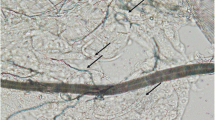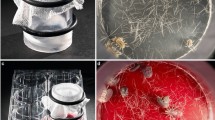Summary
High mortality rates have often been observed when artificial feeding techniques are used for colony maintenance ofOrnithodoros moubata. Such fatalities can be readily controlled by addition of antibiotics to the feeding medium without apparent toxicity to ticks. Comparative results show that for maintaining colonies ofO. moubata artificial feeding techniques can be as efficient as direct feeding on swine—the primary hosts of these argasids.
Résumé
L’alimentation artificielle utilisée pour la maintenance d’une colonie d’Ornithodoros moubata a entraîné de forts pourcentages de mortalité. Ces pertes peuvent être contrôlées par l’addition d’antibiotique au liquide nourricier, sans toxicité apparente pour les tiques. Des résultats comparatifs montrent que pour la maintenance de colonies d’O. moubata, les techniques d’alimentation artificielle sont aussi efficaces que l’alimentation sur porc, hôte primaire de ces argasidés.
Resumen
Se ha observado gran mortalidad deOrnithodoros moubata, en colonias alimentadas artificialmente. Esta puede controlarse fácilmente, añadiendo antibióticos al medio artificial, sin producir toxicidad a las garrapatas. Los resultados comparativos demuestran, que la alimentación artificial de colonias deOrnithodoros moubata es más eficiente, que la alimentación directa de las garrapatas en cerdos, huéspedes naturales de estos argásidos.
Similar content being viewed by others
References
Kemp, D. H., Stone, B. F. &Binnington, K. C. (1983).Physiology of Ticks, (Eds. F. D. Obenchain and R. Galun). 1st edn. Pergamon Press, Oxford, pp. 118–169.
Mango, C. K. A. &Galun, R. (1977).Experimental Parasitology,42, 282–288.
Osborne, R. W. &Mellor, P. S. (1985).Tropical Animal Health and Production,17, 31–38.
Owens, L. (1981).Australian Veterinary Journal,57, 396–397.
Tarshis, I. B. (1958). Proceedings 10th International Congress of Entomology, 1956, 3, pp. 767–784.
Walton, G. A. (1962). Aspects of Disease Transmission by Ticks. Symposia of the Zoological Society of London, (Ed. D. R. Arthur), 6, pp. 83–156.
Walton, G. A. (1964).Journal of Medical Entomology,1, 53–64.
Walton, G. A. (1979).Recent Advances in Acarology,II, 491–500.
Author information
Authors and Affiliations
Rights and permissions
About this article
Cite this article
Osborne, R.W., Mellor, P.S. Development and mortality ofOrnithodoros moubata after feeding through an artificial membrane. Trop Anim Health Prod 18, 41–47 (1986). https://doi.org/10.1007/BF02359657
Accepted:
Issue Date:
DOI: https://doi.org/10.1007/BF02359657




